

Surprisingly incoherent and boring
... View MoreOne of the best movies of the year! Incredible from the beginning to the end.
... View MoreAll of these films share one commonality, that being a kind of emotional center that humanizes a cast of monsters.
... View MoreA great movie, one of the best of this year. There was a bit of confusion at one point in the plot, but nothing serious.
... View MoreThree Violent People is directed by Rudolph Maté and adapted to screenplay by James Edward Grant from a story co-written by Leonard Praskins and Barney Slater. It stars Charlton Heston, Anne Baxter, Gilbert Roland and Forrest Tucker. Out of Paramount Pictures, it's a VistaVision production with Technicolor photography by Loyal Griggs and music scored by Walter Scharf.It's post Civil War Texas and Confederate Captain Colt Saunders (Heston) finds himself with a bride (Baxter) who has a secret past, and taxable assets at his ranch that scheming Carpetbaggers want for themselves. Into the mix comes Colt's brother Cinch (Tryon), who is minus an arm from an accident in childhood; where Colt was his heroic saviour. Things will come to a head as resentments, skeleton's in closets and post war greed will fracture the dynamic of the Bar S ranch.Try to remember that people aren't perfect. They just aren't. They make mistakes. And when they do, they suffer. They pay. Inside themselves they pay.It made little impact back on release in 56, where the release of Heston's other film that year, The Ten Commandments, dwarfed it considerably and simultaneously propelled Heston into the big league. It didn't help that Three Violent People is a very character driven picture, literate and heavy on the melodrama. This is no gunslinging action based bonanza, this features interesting characters talking a lot, where the screenplay has the big players nicely drawn, creating a pot boiler that only rewards those open to an intelligently paced structure. The title, sadly, is misleading and doesn't do the film any favours.You were one of the rear echelon heroes who hid on General Butler's staff while better men were getting killed in battle.Film has definite links to another "literate" Heston picture from 1954, The Naked Jungle. Sanctimonious macho male takes a wife and recoils when learning of her past. Cue the fleshing out of relationships for an hour until the pot starts boiling over and the pace ups and unfolds with a pleasingly suspenseful third act. Action until that third act is sparse, though there's good drama to keep one interested, very much so. This is also a gorgeous picture to look at, not just the rugged but beautiful landscape around the Bar S (Arizona), but also the colours that beam out from the screen, Loyal Griggs' (Shane) photography reason enough to seek this undervalued Western out.I got the one with the red hair ready for the buzzards.Lead cast performances are up and down, Baxter and Heston's chemistry is fine and sexy, but they do appear to be in competition with each other to see who can steal a scene. Baxter, looking positively ravishing throughout, really over does it early in the pic, while Heston forgoes his most agreeable subtlety from those early passages to ham it up later in the day. The best performance comes from Roland (Cheyenne Autumn), who as Bar S gran vaquero, Innocencio Ortega, not only looks immeasurable cool, he also casts a humanistic shadow over proceedings. Tryon, whose edgy one armed brother adds major spice to the narrative, turns in a rare effective performance.The problems are evident throughout, some over soaping by actors who should have known better and the villains are badly in need of flesh on their bones. Yet this is a Western that plays better now to Western fans than it would have done back in the 50s. Where the character driven bent can be appreciated without expectation of a "yeehaw" fuelled Oater. This be one for the ears, eyes and the brain rather than the pulse. 7/10
... View MoreI consider this movie to be one of the greatest westerns I have ever seen (which means one of the best westerns out of more than hundred of the most interesting and important movies in the genre)! Some people seem to think that it is a rather ordinary western about people fighting for land - but it is definitely primarily a film about three characters who has been having rather rough lives and who, in the course of the movie, all get a chance to get things back together. The interest of the movie simply is whether they will succeed in this. The three characters are played by Anne Baxter, Charlton Heston and Tom Tryon and, in my opinion, they all put on a fantastic show. First and foremost, though, Anne Baxter. It is definitely her movie - although she gets tough competition by Gilbert Roland in a fantastic role as Charlton Heston's Mexican "grand vaquero". In my humble opinion Anne Baxter and Gilbert Roland simply creates two of the most memorable characters in the history of the western genre!! The scene where Charlton Heston brings Anne Baxter to his ranch and she is greeted by the Gilbert Roland and his sons is hilariously funny and deeply moving and is a great example of the virtues of this great off-beat western.
... View MoreThis is a thoroughly ordinary western with Charlton Heston heading the cast as a Civil War veteran returning home with his new wife (Anne Baxter) whom he ultimately discovers has had a rather dishonorable past. On top of that he has to deal with carpet baggers and the jealousy of his one-armed younger brother (played by Tom Tryon) who decides he has a lot of old scores he needs to settle. There's not very much to thrill about here, and none of our three principals are very "violent", but it's a treat to watch Baxter and Heston together again after their stint in THE TEN COMMANDMENTS. For what it's worth, Robert Blake is featured in a role as a young Mexican. ** out of ****
... View MoreI saw this film when it was released in 1957 and remember very well that I did not like it. I saw it again yesterday and loved it. How can one explain that? No doubt that when you get older, your taste might change, but in my case that seldom happens with films. Rather I would conclude that the moods of the times change, so in 1957 there was no mood for this type of film, it was categorized as an average western, probably because people were tired of them. Nowadays when they are so rare you learn how to appreciate the good ones. The story is about the unscrupulous treatment some ex confederates were given by some bandits trying to take advantage of the period that followed the war. Heston is one of them and so is his brother Tom Tryon. Heston marries an ex saloon girl Anne Baxter but he does not know about her old profession. There is not much chemistry between Baxter and Heston, this is the only negative point of the film. He combined better with someone like Eleanor Parker with whom he starred in 'The Naked Jungle'. There is a great shootout, the kind of which you don't see in westerns anymore, they just lost the touch. I also did not understand, like mentioned in a previous comment, who are the three violent people, I only noticed two, Heston and Tryon. Baxter? No way.
... View More